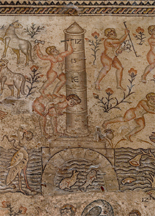 The Old Testament
may seem like an unlikely source from which to draw inspiration for a modern-day
climatology study. But a story from the book of Genesis — in which Joseph
predicts seven years of abundant crops, followed by seven years of famine for
Egypt — drove researchers to scour centuries of water-level data for the
Nile River to determine if such a cycle actually exists, and if so, what causes
it.
The Old Testament
may seem like an unlikely source from which to draw inspiration for a modern-day
climatology study. But a story from the book of Genesis — in which Joseph
predicts seven years of abundant crops, followed by seven years of famine for
Egypt — drove researchers to scour centuries of water-level data for the
Nile River to determine if such a cycle actually exists, and if so, what causes
it. This Byzantine-period mosaic from northern Israel shows a man carving on a “nilometer” the highest level the Nile reached in that year. The picture inspired geoscientists to revisit historical river-level data and fill in the gaps, to reveal a seven-year cycle. Photograph by Yigal Feliks, by permission of the Israel Nature and Parks Protection Authority.
Climatologists have already combed the abundant Nile River data and revealed a connection between patterns in the water-level cycles and Indo-Pacific Ocean patterns. But large gaps in the data, especially after A.D. 1470, have left this analysis incomplete. Now, Michael Ghil, a geophysicist at the University of California, Los Angeles, developed with colleagues what he calls an advanced technique to fill the gaps. Analysis of the data, published in the May 24 Geophysical Research Letters, turns up evidence for a seven-year cycle that researchers say may be influenced by the North Atlantic ocean.
Ghil, working with Dmitri Kondrashov, the lead author, and Yizhak Feliks, attributes credit for the idea to Feliks, who thought of the possible biblical connection after visiting a Byzantine-period mosaic that was created a century or two before the start of the Nile River flood records in A.D. 622. It shows a man clambering to etch onto a column — called a “nilometer” — the highest level reached by the Nile that year.
Locals routinely monitored water levels for the following 1,300 years because the Nile directly affected their agricultural livelihood. Annual summer floods covered the region and then receded, leaving behind arable soil for winter crops. The resulting data, among the longest climatic records available, have been of great interest to climatologists. “People have analyzed such records for a long time, going back to the early 20th century,” Ghil says.
The dataset, however, as extensive as it appeared, was not without problems. Typically when working with historical climate records, more data gaps exist in the beginning. But for the Nile records, the early dataset between A.D. 622 and 1470 seems to be fairly complete. After 1470, however, full decades of data went missing, and the record ended in 1922. Previously, researchers replaced the missing data with the mean value, which was not always accurate. “The resulting records were analyzed using fairly traditional methods,” Ghil says.
To better fill in the gaps, Ghil and colleagues used an advanced form of the Singular Spectrum Analysis, which helps to separate data into statistically independent components that the researchers can classify as a trend, oscillations or noise. “Using data adaptive methods, we are actually interrogating data in a much more intensive manner,” Ghil says.
“They used a more advanced, sophisticated statistical method than previous researchers,” says Matthew Lachniet, a paleoclimatoligist at the University of Nevada, Las Vegas. What struck him about the study was the decision to include in the models not only the high-water levels, but also the difference between high and low measurements. “It’s not as common as only looking at high levels,” Lachniet says. “I think it’s an interesting contribution.”
With the gaps filled in, Ghil and colleagues discovered multiple cycles in water levels, ranging on scales from two to 256 years, which they say can be attributed to several known influences, including that of the El Niño Southern Oscillation (ENSO) from the Pacific Ocean. But the most striking cycle had a seven-year period, which Ghil thinks is due to an additional influence from the North Atlantic Oscillation (NAO), the Atlantic’s version of the Pacific’s ENSO.
Models of the North Atlantic’s variability and of the NAO — characterized by changes in air pressure and storm tracks — show that they contribute to weather patterns in Europe, the Middle East, central Asia and North Africa. But according to Ghil, the influence likely extends farther south, all the way to the East African sources of the Nile River. He and his colleagues found that the Nile’s seven-year cycle parallels a known seven- to eight-year peak in recorded NAO data. “Making that link to the North Atlantic doesn’t surprise me,” Lachniet says. “The North Atlantic has dominant control on climate globally.”
Ghil says that short periodicities of ENSO have been used to predict future Nile River water levels, but the newly detected NAO cycles have not yet been used as such. The first step would be to contact the hydrological services in Egypt, Sudan and Ethiopia, and gather at least 30 to 40 years of recent Nile data, Ghil says. “That would be fun.”

